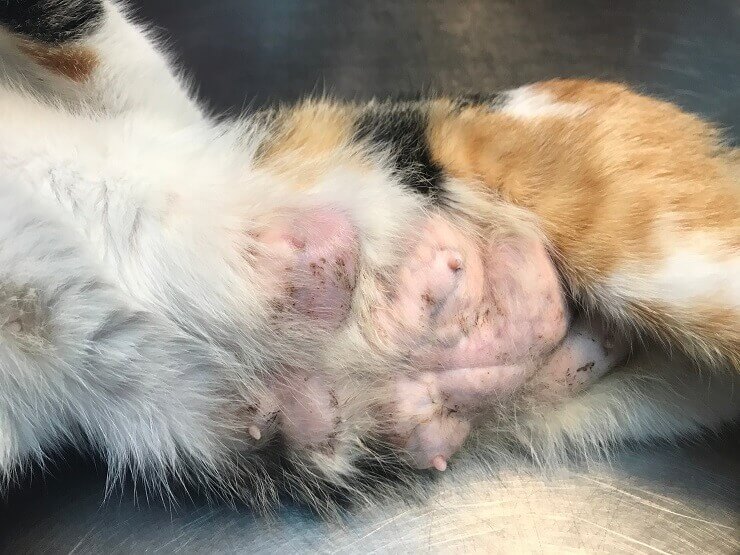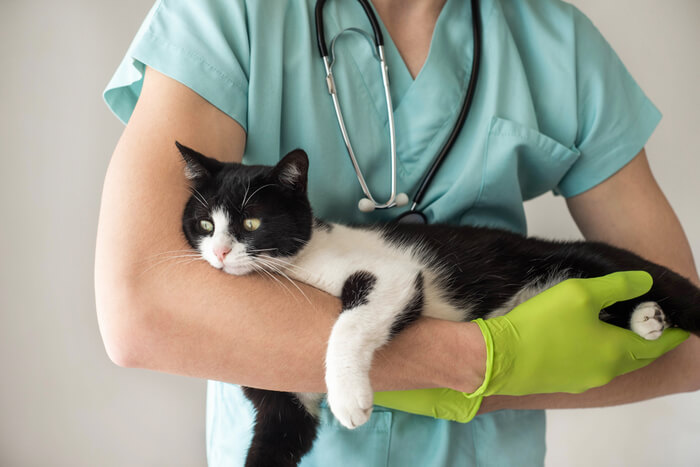
Cancer is a scary word whether in talking about our human loved ones or our feline friends. If your cat has been diagnosed with cancer, understanding some basics about it can be helpful in knowing what to do and what to expect as you navigate this difficult medical diagnosis.
What Is Cancer?
Cancer is the excessive growth of abnormal cells in the body. This typically results in a collection of abnormal cells that divide uncontrollably resulting in a tumor, or growth.
These masses can invade normal tissue to cause disease. Tumors are classified as either benign or malignant. Benign tumors are growths that are less invasive, non-cancerous, and don’t spread to other tissues.
Malignant tumors are those that are invasive, aggressive, fast-growing, cancerous, and tend to spread to other parts of the body. Metastasis is the spreading of the cancerous cells from the primary tumor location to another part of the body via the blood or lymphatic systems.
Types of Cancer in Cats
There are many different kinds of cancer that affect cats, some worse than others, and some more common than others. In general, cats are afflicted with cancer less often than dogs, but when a cat is diagnosed with cancer, it tends to be more aggressive in a cat compared to the dog.
Because cats are living so much longer than they used to, we are seeing cancer in more and more cats as they age into their geriatric years.
Even though cats can get many different types of cancer, there are a few that are seen more commonly in the feline species.
Lymphoma

Lymphomas most commonly develop in the gastrointestinal tract, but they can develop throughout the body.
Lymphoma is cancer of specific white blood cells called lymphocytes. Lymphocytes are circulated through the body via the blood and lymphatic systems and are found in many different tissues all throughout the body.
Lymphoma is considered a systemic cancer, meaning that it is not localized in one particular area. Lymphocytes are found accumulated in lymph nodes but can be found in the blood as well as other organs.
Lymphoma is one of the most common types of cancer seen in cats. Cats with the Feline Leukemia Virus (FELV) or Feline Immunodeficiency Virus (FIV) are at a higher risk of developing lymphoma, although this cancer can be found in any sex, age, or breed of cat.
There are different forms of lymphoma categorized by which body system or organ the cancerous cells around found. Keep in mind that this cancer can be found in more than one organ.
Gastrointestinal Lymphoma
This type of lymphoma involves the intestinal tract such as the stomach, small, and large intestines, and often some of the organs around the intestinal tract. Cats with gastrointestinal lymphoma show signs of vomiting, diarrhea, anorexia, and weight loss.
Renal Lymphoma
Renal lymphoma involves the kidneys. The cancerous cells invade the kidneys causing symptoms of kidney failure such as anorexia, vomiting, weight loss, polyuria, and polydipsia.
Mediastinal Lymphoma
This is lymphoma of the thoracic cavity, specifically, the mediastinum, which contains lymphatic organs such as the thymus and lymph nodes.
Nasal Lymphoma
This type of lymphoma is the only one that tends to be more localized to one specific area – the nasal cavity. These cats tend to have a swollen nose, nasal discharge, sneezing, and upper respiratory congestion.
Multicentric Lymphoma
This lymphoma occurs when the cancerous lymphocytes are found in multiple lymph nodes and various organs.
Mammary Gland Cancer

Among the types of cancer a cat may develop is breast cancer. This type of cancer involves masses that develop in one or more of the mammary glands.
Mammary gland cancer is breast cancer in cats and is usually diagnosed as a mammary carcinoma. Mammary tumors can be found in one or more mammary glands and are a very aggressive form of cancer. It tends to be a more malignant type of cancer in cats compared to dogs. It is mostly seen in intact (unspayed) female cats.
If this cancer is diagnosed early, surgical excision of the mammary mass can be successful in removing the cancer or slowing the progression of the disease. However, many times, this cancer quickly spreads to the nearby lymph nodes and to the chest.
Squamous Cell Carcinoma
Squamous cell carcinoma (SCC) is a type of cancer involving skin cells and cells of the oral cavity. It is the most common cancer found in the mouth of cats. This cancer can also be found on or in the nose, face, or ears.
Cats with SCC might have foul-smelling breath, discharge from the nose or mouth, swelling, or lesions on the face, nose, ears, or mouth.
Surgery can be helpful in removing the cancer if it is done early when the lesion is small, however, this is a fast-growing and invasive tumor which may not be easily removed.
Soft Tissue Sarcoma
Soft tissue sarcomas are also known as injection-site sarcomas or fibrosarcomas. This type of cancer involves a locally aggressive mass under the skin but is typically slow to spread to other tissues.
Treatment involves surgical removal of the mass and radiation and/or chemotherapy.
Osteosarcoma
This is a type of cancer that affects the bones. Cancerous cells destroy the bone tissue causing the bones to become weakened and easily fractured. Osteosarcomas are painful, aggressive cancers that spread easily and quickly.
Treatment involves amputation of the limb affected, sometimes combined with radiation and chemotherapy.
Mast Cell Tumor
Mast cells are blood cells involving in the immune system. Mast cell tumors occur when those cells become cancerous and start releasing toxic granules. Sometimes causing allergic reactions.
These tumors can occur on the skin or internally on various organs. Skin tumors are found as lumps or bumps that vary in size. These can typically be surgically removed. Visceral mast cell tumors on internal organs are more difficult to diagnose and treat and are more serious.
Symptoms of Cancer
Because there are so many different types of cancers in cats that can affect any organ or body system, the symptoms of cancer can vary tremendously. More often than not, cancer is found in senior cats, geriatric cats, those predisposed to illnesses, and cats with suppressed immune systems.
There are some common signs and general symptoms that should raise concern and warrant a workup by a veterinarian.
- Masses or tumors of any size or shape
- Anorexia (loss of appetite)
- Weight loss
- Vomiting
- Prolonged diarrhea
- Lethargy
- Non healing wounds
Cancer Diagnosis in Cats
When you bring your cat to your veterinarian suspecting cancer, they will start by performing a physical examination, weighing the cat, and taking some basic vital measurements.
If the cat has a mass or nonhealing wound, then samples are taken for diagnostics.
One noninvasive way to take samples is a fine needle aspirate, where a small sample of cells is taken for analysis. This typically doesn’t require sedation, anesthesia, or surgery.
Another way to take samples is by a biopsy, this is where either a part of the tumor or the entire tumor is removed and sent for analysis.
This is more invasive and typically requires, sedation or anesthesia, and surgery. These samples are sent to a pathologist for analysis to determine what type of cancerous cells, if any, are present.
In cats where a distinct mass isn’t present, or in those cats who are showing other signs of generalized illness, other tests are performed to narrow down what is wrong.
Bloodwork is one way to determine internal organ function and blood cell health.
Bloodwork is helpful in diagnosing kidney, liver, and thyroid disease, anemia, infection, and other abnormalities internally. Testing for feline viruses such as Feline Leukemia Virus and Feline Immunodeficiency Virus is also done via blood samples.
Radiographs, or X-rays, is a form of imaging to see if there are abnormalities in the bone tissue or internally in the chest or abdomen.
Ultrasound is another form of imaging to assess the chest and abdomen. Imaging can help find masses or other abnormal changes in internal organ tissues.
More advanced imaging is also helpful in many cases. This type of imaging involves MRIs (Magnetic Resonance Images) or CT scans (Computed Axial Tomography scans). These are especially helpful in diagnosis cancer of the neurologic system.
Treatment of Cancer in Cats

Fortunately, cancer is treatable. While treatment doesn’t always cure cancer completely, there are options to increase your cat’s quality of life for as long as possible.
Just because a cat is diagnosed with cancer, doesn’t mean it is an instant death sentence. Modern medicine and technology are advancing not only for people, but for pets too. There are often many treatment options available to cat owners.
Treatment doesn’t always cure cancer completely. Sometimes the goal of treatment is to reduce clinical symptoms and prolong a good quality of life as long as possible.
It is always best to discuss treatment of cancer in your cat with your veterinarian to determine if treatment is the best option and what type of treatment is appropriate.
Many times, your regular veterinarian will refer you and your cat to see a cancer specialist, called an oncologist. Oncologists are veterinarians who have undergone specialized advanced training in the area of cancer treatment and research. These oncology specialists typically have access to more treatment options than a general practitioner.
In general, treatment for cancer in cats includes:
- Surgery– Surgery is typically done to remove cancerous tumors. It is the form of treatment most likely to be curative.
- Radiation therapy– This involves an intense beam of radiation (stronger than X-rays) directed at the cancer to kill cancer cells. Radiation is delivered by machine and experienced personnel in several treatments. It is often used after surgery and in combination with chemotherapy.
- Chemotherapy– Chemotherapy involves administering anti-cancer drugs and medications. These drugs can be given orally, by injection, and sometimes topically.
Sometimes, treatment may not be the best option for the cat or cat owners. In these cases, palliative hospice care can be an option to ensure a good quality of life until the cat owner decides to euthanize. Palliative care can involve pain control, appetite stimulants, anti-nausea medications, fluids, and other medications and treatments as needed to keep the cat comfortable.
Prognosis of Cancer in Cats
Cats diagnosed with cancer can have a varying prognosis depending on the type of cancer, location, and other associated symptoms. The prognosis will also depend on what treatment is available and if that treatment is successful.







